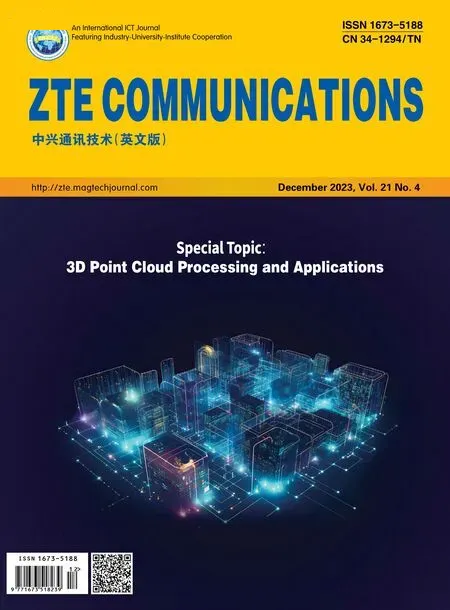Special Topic on 3D Point Cloud Processing and Applications
3D point cloud processing has redefined the way we perceive and interact with digital spatial data. By translating physical entities into a collection of 3D points, it offers an accurate digital model of our surroundings. This emerging field of 3D point-based representation has piqued interest significantly over recent years, owing to its capacity to depict detailed spatial environments, thereby bridging the gap between virtual and real dimensions. Numerous applications,including virtual reality, augmented reality, and advanced mapping, have greatly benefited from this technology, allowing for immersive experiences and accurate spatial analysis. However, the journey from raw spatial data to refined point cloud representations is fraught with challenges, including storage and computational demands, noise handling and the quest for efficient compression techniques.
In this special issue on 3D point cloud processing and applications, we present a curated series of articles that dive deep into these challenges, suggesting innovative strategies and methodologies tailored to address them. The selected contributions touch upon a diverse spectrum of topics within the realm of point cloud processing. They discuss novel compression algorithms, delve into quality assessment metrics, elucidate advanced rendering techniques, and highlight the nuances of feature extraction, among other pivotal areas. The call for papers for this special issue attracted excellent submissions, indicating the growing significance of this field. Following rigorous reviews, we are proud to present six standout papers that not only showcase cutting-edge research but also set the direction for future endeavors in this domain.
The first paper titled “Perceptual Quality Assessment for Point Clouds: A Survey” delivers a comprehensive overview of how the visual quality of point clouds is gauged. Traditional quality assessment methods fall short when applied to point cloud data. This survey presents the significance of point cloud quality assessment, discussing common distortions, experimental setups, and subjective databases. It contrasts model-based and projection-based objective methods, and the performance of these methods across various databases is analyzed. Experimental insights underline the utility and efficacy of the presented methods.
The second paper titled “Spatio-Temporal Context-Guided Algorithm for Lossless Point Cloud Geometry Compression”addresses the challenges faced during the compression of point cloud data. Traditional compression techniques struggle with the irregular distribution of point cloud data in space and time. This paper introduces an innovative context-guided algorithm that slices point clouds and employs the travelling salesman algorithm to predict compression. Testing results emphasize its robustness, presenting a feasible avenue for efficient 3D point cloud compression (PCC).
The third paper titled “Lossy Point Cloud Attribute Compression with Subnode-Based Prediction” shines light on the advances in 3D point cloud compression. With the Moving Picture Expert Group (MPEG) working towards a standard for PCC, the paper highlights the challenges in current attribute compression techniques. It introduces a subnode-based prediction method, leveraging spatial relationships for improved precision. Experimental results showcase its superior performance over existing MPEG standards.
The fourth paper titled “Point Cloud Processing Methods for 3D Point Cloud Detection Tasks” revolves around the pivotal role of 3D point cloud processing in object detection.Given the complexity of data acquired from LiDAR sensors,the paper offers a review of point cloud processing methods and how they influence detection outcomes. The discussion underscores the evolution of voxelization and sampling strategies, emphasizing their implications for feature extraction and final detection performance.
The fifth paper titled “Perceptual Optimization for Point-Based Point Cloud Rendering” delves into the challenges in point-based rendering for point clouds. The established method of determining rendering radius using neighboring points' distances is problematic. The paper introduces an outlier detection mechanism that optimizes the perceptual quality of rendering, using local and global geometric features to detect outliers. Results confirm the significant improvements in rendering quality with this approach.
The sixth paper titled “Local Scenario Perception and Web AR Navigation” explores the exciting convergence of web technologies and augmented reality (Web AR). As Web AR grapples with computational demands, the paper introduces an indoor navigation system based on local point cloud map positioning. This novel approach minimizes the need for external sensors, highlighting a promising avenue for precise and widespread application of Web AR navigation.
To conclude, this special issue aims to be an indispensable guide for researchers, industry experts, and students delving into 3D point cloud processing and its varied applications. We anticipate that the content will spur more research and advancements, shaping the future trajectory of digital spatial data analysis. Our deepest gratitude extends to all the authors,reviewers, and editorial staff for their invaluable contributions that have made this issue a success. We earnestly hope that the articles in this special issue offer both clarity and insight to all readers in this emerging domain.
- ZTE Communications的其它文章
- Table of Contents, Volume 21, 2023
- Beyond Video Quality: Evaluation of Spatial Presence in 360-Degree Videos
- Mixed Electric and Magnetic Coupling Design Based on Coupling Matrix Extraction
- A Hybrid Five-Level Single-Phase Rectifier with Low Common-Mode Voltage
- Incident and Problem Ticket Clustering and Classification Using Deep Learning
- Research on Fall Detection System Based on Commercial Wi-Fi Devices

